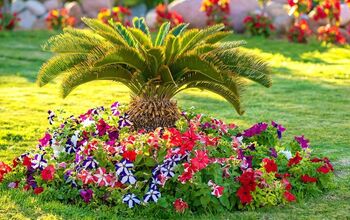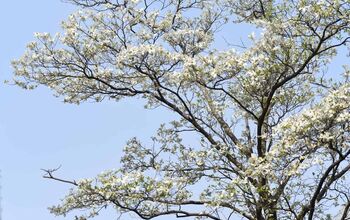25 Types Of Palm Trees (With Photos)

As a fan of retrowave music, I am a palm tree fan by default. I love palm trees. As in, I actually want to move to California as a result of them having palm trees. I wish I was joking, but I’m not. With that said, it only became recently clear to me how many different types of palm trees there are out there. The palm family is way larger than album art suggests!
The most commonly recognized types of palm trees include coconut trees, banana trees, date palms, palmetto palms, and Mexican palms. However, many people aren’t aware of Chinese palms, windmill palms, or canary palms. One of the best palm trees for colder areas is the European palm.
It’s important to remember that there are literally dozens, if not hundreds, of palm tree species out there. We’re going to take a closer look at the different types of palm trees that you can get.
The Many Different Types Of Palm Trees You Can Plant
For the sake of this article, we’re going to focus on the types of palm trees that you can actually buy and plant in your home. After all, talking about rare exotic palms isn’t going to do you much good if you can’t get them in your yard.
1. Coconut Palm Tree
To a point, coconut trees are a bit of a media trope. In almost any cartoon you have involving a deserted island, people survive off coconut trees. It’s a vibe, I guess. Believe it or not, coconut trees are very real and are a legitimate type of palm tree. They also happen to be pretty popular in Florida.
Unlike other categories of palm trees, there is only ONE species of coconut tree out there. All the rest were extinct as a part of the end of the age of dinosaurs.
2. Date Palms
Date trees are like the underappreciated branch of palm trees that make edible food. There are several different types of palm trees that produce these fruits, and most of them are pretty darn tall in height. This is, of course, with the exception of Pygmy Date Palms, which grow to a maximum height of about 3 to 3.5 feet.
These trees are most common in the Middle East and the Mediterranean, where date farms are pretty popular. If you want to have delicious dates, it’s important to remember that smaller trees tend to produce less flavorful fruit. So, stick to outdoor palms if you can.
3. Banana Palm Trees
If you’ve ever sunk your teeth into a banana, then you have also happily eaten the fruit from a popular palm tree. There are literally dozens of different banana palm trees that you could potentially plant in your yard…provided that you live in a warmer climate that’s amenable to the growth of palm trees.
There are several popular options that you can choose here, including the Cavendish (what you eat at the grocery store) and the Blue Java. Blue Java’s are cool because they apparently taste like vanilla ice cream.
4. Sabal Palmetto Palm Trees
If you live in the United States, then chances are that most of the palm trees that you see in nature near beaches are a type of palmetto. We love our palmettos here. In South Carolina, the Sabal Palm/Palmetto is the state tree. With that said, there are a lot of different palmettos that this could refer to.
The most popular type of palmetto tree to plant outside a home is a Sabal (or Saw) Palmetto. However, you can also get smaller palm trees that you can plant indoors that fit this category. A good example of this is the McCurtain’s Dwarf Palmetto. It also happens to be one of the most cold-hardy palm trees out there.
5. Mexican Fan Palm Trees
Tall and gangly, it’s hard to ignore how much height these palm trees have. Mexican palm trees are some of the tallest in the world, not to mention some of the most striking. Their leaves can grow up to 3.3 feet wide. As far as their heights? Well, you can expect them to reach as tall as 82 feet or more.
As one can glean from the name, Mexican fan palm trees do well in coastal areas of Mexico and Central America. This is actually a type of date palm tree, which means that you might get some fruit out of these babies too. This is one of many major categories of “fan” palm trees, which means that they tend to have leaves that fan out.
6. Bulgarian Windmill Palms
When I found out that Bulgaria has palm trees, my jaw dropped a little bit. Bulgarian Windmill Palms are known for being relatively short and being shockingly cold-resistant. These palms only grow up to 12 feet in height, and have leaves that shoot out every which way.
Believe it or not, this is one of the only palm tree types in the world to be able to withstand temperatures that drop below 0. They are hardy up to zones 7b, which means that you can actually get a palm tree like this one to survive in New Jersey, or even certain parts of Connecticut!
7. Pindo Palm Trees
Pindo palm trees are a fairly large group of palm trees, and as you can tell from the photo above, many make berries that are often turned into a sweet-tasting jelly. Also known as “jelly palms,” these trees are short and slow-growing, which makes them ideal for people who want to have fruit within arm’s reach…literally.
These palm trees have another major perk that American families tend to enjoy. They happen to be pretty hardy, which means that you can usually plant them in areas that are not typically associated with palm trees. So, if you’re someone who enjoys Southern trees but doesn’t live in the South, then this is a good choice.
8. European Fan Palm
European fan palms are also called Mediterranean palms, and they look almost identical to Bulgarian palm trees. They have the same large, fanning leaves that make people smile. They also tend to have similarly long fronds. The difference is that these tend to be a lot larger than their Bulgarian counterparts.
It’s not uncommon for these palm trees to grow 10 feet wide or 15 feet tall. They’re a bit bushier than most other Europe-based palms. Like Bulgarian palms, they are remarkably cold hardy and can last in zones up to 7b. So, it’s another option to consider.
9. Needle Palm Tree
Behold, the needle-y tips of the Needle Palm Tree! (It was hard to find a full photo, but hey, I got the tips!) Needle palms are some of the most durable, if not the most durable palms when it comes to matters of cold and ice. Like, these are resilient up to zones 5b. So, these are actually the only types of palm trees you might see in places like Rhode Island.
Though they can hang out in places like New Jersey, these palm trees are actually native to the Southeast United States. They can handle the West Coast’s temperatures pretty well, but they still seem to thrive better on the East.
10. Mazari Palm
Mazari palms aren’t exactly what most people would consider to be trees, per se. They’re more like short, stubby bushes that belong to the palm tree family. Like many other palms, these have beautiful fan-shaped palms and are cool-looking. Their leaves grow to a maximum of four feet high and have greyish or silver-green fronds.
Unlike other types of palm trees on this list, this is a species that is actually native to Asia. So, if you are looking for an exotic flair to your home, this could be it. Bonus: it’s also a fairly cold-hardy one, too.
11. Dwarf Majesty Palm
Aren’t these so cute?! Oh my god, I’m in love with them. Dwarf Majestic Palms are one of the most popular palm trees to plant in a pot, but they are often used in subtropical gardens. These single-trunk trees have leaves that can grow up to three feet in length and have a gorgeous top that’s bound to get a lot of quality compliments.
There are a lot of ways that you can jazz up this tree, but let’s just be honest. They are great centerpieces because of how elegant their fronds look. So, don’t be afraid to use it as a focal point. This is a great way to make sure that you get the most out of your yard.
12. Christmas Palm Tree
So, I don’t know what caused these palm trees to become famously called “Christmas” palm trees, but they’re native to Florida beaches. These palm trees are smaller than most others, topping their heights at 25 feet. Their relatively short stature makes them perfect ornamental palm trees for Floridians who want to have a nice twist to their lawn.
These are pinnate palm trees that tend to have long portions of green up near the top of their trunks. Since they’re rather petite compared to most other palms, they tend to be easier to wrap string lights on. With that said, they don’t need lights to survive and do best in tropical regions.
13. Zombie Palms
Spooky name, spooky history: that’s the zombie palm in a nutshell. This is a palm tree native to Haiti, and it’s famous for the spooky palm needles that span out of its trunk. (You can see them above.) So, you might be wondering what on earth would make people call these palm trees “zombies.” Well, it actually is a cultural thing.
Haiti is one of the biggest hotspots for voodoo/voudoun/hoodoo practitioners. The spines that you see on the trunk of these palm trees are actually what are traditionally used in piercing voodoo dolls. While this doesn’t really have much to do with the religious aspect of making a zombie, it’s still related enough to make people associate these trees with the practice.
14. Chinese Windmill Palm
There are few palm trees that have quite as quirky an appearance as Chinese windmill palms. These are native to temperate forests in China, and have proven to work quite well in temperate zones around the US too. These palm trees have a thicker, barky base and small bursts of palm leaves up top.
Most people will notice that the leaves don’t have the same kind of “droop” or overhang that most other palm trees do. That’s part of the reason why they can look a bit alien at first. Though they can grow up to 40 feet in height, they’re adaptable and can grow in containers too. Shocking? Yeah, I felt that way too.
15. Triangle Palms
Are you looking for a showstopper of a palm tree? Then you might want to take a look at these. Triangle palms are pinnate palm trees that grow absolutely massive palm fronds. Like, really. They’re huge, and can max out at 8 feet in most of these trees.
They get their name because these palm trees grow their leaves (or fronds, whatever) in a unique 120-degree angle. This gives them a unique upside-down triangle appearance that sometimes looks like a peacock flaunting its tail. Needless to say, these medium-sized trees are definite attention-grabbers.
16. Silver Saw Palmetto Palms
Most types of palm trees are green with a splash of brown. Ho hum. If you want to have a palm tree that has a different take on color, then look no further than Silver Saw Palmetto trees. The photo above says more than I ever could about these amazingly pretty plants.
Native to the area of the Gulf Coast of Mexico and Florida, Silver Saw Palmettos are famous for starting out green and turning a brilliant, ghostly white. They can grow up to 15 feet tall, and their palm fronts can easily span 4 feet. Breathtaking, no? Thankfully, these shocking trees are fairly easy to grow.
17. Foxtail Palm Trees
Foxtail palms are pretty aptly named, primarily because they have palm fronds that are fluffy and bushy, just like a fox’s tail. These gorgeous palm trees have a very proportional look, but still carry the classical palm aesthetic that people tend to enjoy for their homes. They’re just plain beachy, ya know?
These palms love the heat and need to be planted in the warmest parts of the country to flourish. The best thing to do is give these trees at least 8 to 10 feet of leeway so that their fronds can unfurl. Otherwise, you might end up with a branch that’s destroyed…or destroying other things.
18. Wax Palms
Also known as Caranday palm trees, these are both famous for being both ornamental and useful. If you are looking for a palm tree that can offer a good ingredient in the form of wax, this is it. These palm tree leaves secrete a waxy substance that acts as a main ingredient for car polish, furniture polish. candles, as well as cosmetics.
When it comes to growth, these palm trees are a little strange. At first, they look stumpy, with thick trunks that look a bit stocky. As they age, they become extremely tall, often towering at 50 feet high or more.
19. Lady Palm Trees
Lady palms are a bit different than most other types of palm trees discussed here, primarily because they have multiple stems and also are generally seen as an indoor plant. They are small, delicate, and known for their rich dark green foliage. They work best at what most would deem to be “room temperature.”
Because they tend to be low maintenance, lady palms are ideal office plants. They add a pop of color to any room and don’t require too much light, either. With that said, some species of this type can grow pretty tall. They can max out at 13 feet in height.
20. Bottle Palms
These funky plants are known by many other names, including ponytail plants and elephant’s foot palms. However, it’s a little bit of a misnomer to call these “palm trees,” even though they look like most other types of palm trees on this list. You see, they’re not actually a category of palm tree. Rather, they’re actually succulents that look like palms.
Regardless of the fact that they’re succulents or not, most people tend to see them as palm trees. In most ways, you wouldn’t actually be able to tell the difference, anyway. The one thing this group of plants all have in common is the larger, rounded bottom of their trunks. That’s why they’re called bottle trees.
21. Spindle Palms
So, uh, I don’t really know how to describe these aside from saying that they’re awkwardly-shaped. They’re narrow at the base and tip, but fat in the middle. It’s like a spindle. Spindle palms have trunks that have light bands that almost make them look like they’re made out of clay, too.
These palm trees are starting to become status symbols among conservationists, primarily because they are at a threat of extinction in their natural habitats. These require extremely warm environments and cannot survive past zone 10. If you are able to find a place that sells these, count yourself lucky.
22. Yucca Palms
Yucca palms are often considered to be a “hit or miss” type of plant if you want to put these indoor. Certain types of this palm tree have razor-sharp edges, such as the “Spanish bayonet” yucca. Those are ideal for outdoors. If you want something indoors-worthy, go for a less pointy yucca option, like the one above.
Having a yucca palm is a good idea if you’re a bit of a gourmet. Many of the subtypes of yucca have edible flowers that are amazing in drinks and salads. With that said, you really need to watch for the needles on these things. They hurt and should not be near kids or pets.
23. King Palms
Regal as can be, king palms are some of the most popular palm trees to plant in both South Florida as well as its native countries of India and Australia. These palm trees tend to have green stalks at the tips of their stems which occasionally fray out at the tips. Among people who talk about palm trees, these are known as the “crowns” of king palms.
Though this name is generally for Australian king palms, the truth is that this can refer to up to 10 different species. All of them are known for their crowns as well as tall heights. It’s not unusual to see this species grow to heights taller than 40 feet.
24. Jamaican Thatch
Jamaican Thatch is also known as Florida Thatch, and it’s a palm tree that is pretty straightforward. Its name came from the fact that this used to be a building material for thatch roofing. Heck, if you have a tiki bar, you might still use it as thatching. I won’t judge. It’s a green thing.
This is a popular tree type for people who want to have that “windmill” style of palm tree, complete with sunburst fronds. They are surprisingly narrow, so they tend to make for a great choice among people who want a backyard tree that can fit in an otherwise petite backyard.
25. Colombian Wax Palms
So, Colombian wax palms are very unique in the world. In fact, they are so unusual that I felt I had to add them despite them not being too common as backyard plants. These are the tallest palm trees in the world and are only natively found in a small section of Colombia.
These trees are going to be some of the most unusual you’ll see, simply due to the way they grow in nature. They can shoot up to 200 feet in height, even though they’re noted for having long, slender trunks. Amazingly, they don’t fall over or stuff like that. Here they are in their natural habitat. Alien-looking, aren’t they?

Ossiana Tepfenhart is an expert writer, focusing on interior design and general home tips. Writing is her life, and it's what she does best. Her interests include art and real estate investments.
More by Ossiana Tepfenhart




















































